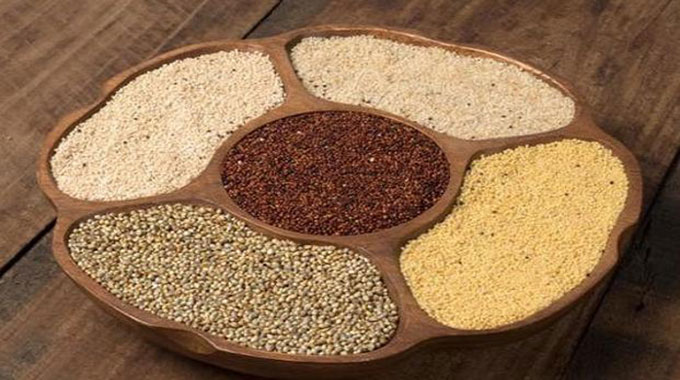Introducing small grains in family diet

Andile Tshuma
SMALL grains are healthier but many households are struggling to introduce them to family diets for a plethora of reasons, including that children reject them on first attempt.
Most parts of the country suffered severe droughts and generally crops did not do well as they succumbed to moisture stress. A lot of households are reported to be food poor and in need of food aid, particularly in Matabeleland South and Government is now tasked with the mammoth responsibility to provide for the thousands of Zimbabweans who will need food aid.
Communities in Kezi, Gwanda and some parts of Lupane have better stories to tell as a number of people are taking heed of calls to grow more drought resistant crops, particularly small grains which have also proven to be even more nutritious than the maize we are so accustomed to. Generally almost everyone did not realise the expected harvest but most of those that planted small grains got something.
Statistics show that there has been an increase in the number of people in Zimbabwe who are suffering from diet-related illnesses such as type II diabetes and hypertension. Reliance on medication meant to alleviate the symptoms has become the norm.
A realisation of the importance of healthy eating, not only in reducing the risk of development of diet-related non-communicable diseases but also in managing them, has been growing among Zimbabweans.
The question to ask ourselves is why our fore fathers and mothers were not starving and were healthier than us even before the advent of modern medicines. They seem to have had great satisfaction in the conditions of their existence with their traditional knowledge systems and knew which foods were best to grow on different soils and which plants and substances cured which ailments. Such knowledge must be fully documented and thanks to the dedicated researchers, a lot of this knowledge is now available for us to see but unfortunately, a lot of the old folk have gone without transferring the knowledge to us.
The answer seems to lie in their diet and lifestyle. A lot of queer, strange ailments today stem from inactive lifestyles and a number of non-communicable diseases are somehow linked to our lifestyles and eating habits.
It is arguable that their health could be attributed, to a large extent, to the food they ate which included small grains such as finger millet, pearl millet, rapoko and sorghum as their major starch sources.
Research has shown that the quality of carbohydrates people consume contribute to the risk of diet related non-communicable diseases. Slowly digestible carbohydrates and whole grains have been shown to reduce the risk of the development of diet-related chronic diseases.
This could explain the good health of the generations gone by since, unlike our current population, their diets included whole, unrefined small grains.
I have attended a number of sessions of the Diabetes Association of Zimbabwe and I have heard them encouraging numerous times, the uptake of small grains in replacement of maize meal, for better diet.
In addition to being endowed with micronutrients and antioxidants, the starch from some varieties of small grains has been shown to be slowly digestible compared to the starch of commonly consumed grains. This means that the release of sugar from small grains is slow and sustained maintaining low blood sugar levels thereby making them ideal for sugar-controlled diets. Slow digestion also means one feels fuller for longer.
It is quite unfortunate for our modern day population that commercial foods based on indigenous small grains have been scarce and can mostly be found in either amahewu as ground meal yet in other countries, you find rice like dishes made from millet and sorghum where the grain is boiled and eaten with stews and other hearty dishes, which makes it more interesting and less monotonous.
The reasons for low uptake seem to lie in the perception that consumption of such foods was indicative of social status and secondly their processing was so cumbersome manually and in most cases one would find a lot of stone particles due to the methods of preparation available.
However, lately more and more manufacturers are working on products based on indigenous small grains apart from ‘isitshwala’, in addition to the improved processing methods that have made the small grains more palatable for both the younger and older generations.
Health benefits are driving many people in communities towards the consumption of these small grains. It is wiser to introduce them gradually to your diet than to wait until a doctor completely forbids you from eating maize meal products.
It can be difficult to convince children at home to eat small grains however, the attitude of the adult in the home towards the small grains goes a long way in shaping the attitude in children and a little effort in trying more innovative recipes while introducing small grain foods helps.
Zimbabwe still lacks a solid policy framework to promote the production of indigenous vegetable seed such as tsunga, okra varieties as well as indigenous seed varieties for sorghum, millet, cow peas, pumpkins and a whole range of the country’s crop diversity.
Agriculturalists note with concern the disappearance of indigenous crop and vegetable varieties at a time when nutritional density is much more important than yields per hectare and say fewer crop species are feeding the world than 50 years ago, raising concerns about the resilience of the global food system.
Loss of diversity means more people are dependent on a few key crops, leaving them more exposed to harvest failures.
According to the UN Food and Agriculture Organisation, the diversity of cultivated crops declined by 75 percent during the 20th Century and a third of today’s diversity could disappear by 2050.
It is therefore important to make efforts to eat healthier now than to wait until it’s too late and a doctor’s order forces a rapid change to your diet to save your life. Make a choice.








Comments